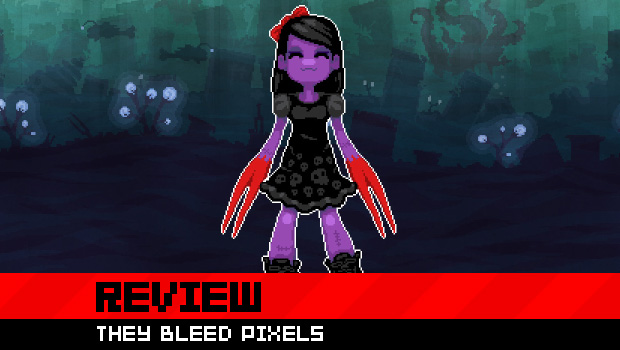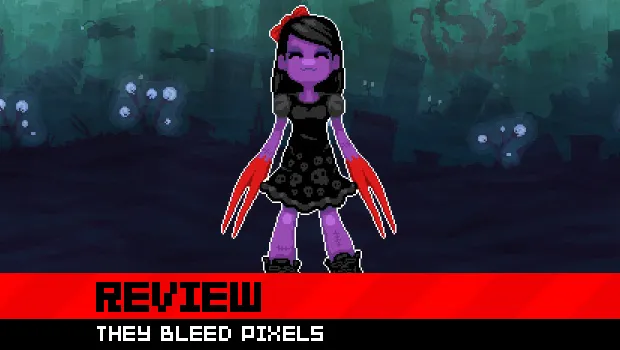Death and dismemberment await you
Amusing story: I was sent a beta code for They Bleed Pixels so that I could get a little hands-on time before the official release. For some reason, Steam wouldn’t run the game, forcing me to spend the bulk of the evening and the following morning trying to get the thing to work. Turned out to be a faulty installation of the bundled XNA Framework.
However, I like to think that the real reason I was denied access was because Steam was trying to protect me from the very Lovecraftian evil that serves as the game’s focal point. There is a sinister force at play here, one that tempts you deeper inside its gaping maw, and it’s out for blood — your blood.
Slight exaggeration, of course. Though the dangers might be too severe at times, They Bleed Pixels is still enjoyably gruesome.

They Bleed Pixels (PC)
Developer: Spooky Squid Games
Publisher: Spooky Squid Games
Released: August 29, 2012
MSRP: $9.99 ($7.99 until September 5)
At the Lafcadio Academy for Troubled Young Ladies, a nameless girl discovers a strange, bleeding tome in the library. An otherworldly power from within the book causes her to have macabre dreams in which her skin turns purple and her hands become long, bloody claws. Though she doesn’t mind the dreams at first, she quickly becomes distraught as her body starts undergoing the same transformation in the real world. But no matter how many times she tries to discard or destroy the book, it keeps finding its way back into her room, infesting her slumber with ever more disturbing visions.
Some folks may compare They Bleed Pixels to other recent, brutally hard platformers such as Super Meat Boy, but I find it has more in common with Battletoads on the NES. In addition to high-tension running, jumping, and dodging, both titles have combat systems that wouldn’t be uncommon in your typical brawler. And like how Battletoads baddies meet their end by one of the game’s iconic finishers, enemies in They Bleed Pixels are similarly dispatched in style, capped by a satisfying splatter of pixelated plasma.
Taking a page out of Super Smash Bros., you have access to a bevy of techniques via context-sensitive, single-button commands. Depending on which direction button you are holding or whether you’re airborne, pressing the attack button will execute a jab, kick, air juggle, dive, dash, or one of a number of other abilities. You can also use the environment to your advantage by launching foes into walls of spikes or spinning buzzsaws, adding to your combo chain.
You can’t button-mash your way to victory, as most enemies are able to defend against blind attacks. You’ll spend the first few levels getting a feel for how to best approach each foe, then you’ll start facing multiple varieties at once, putting your skills to the test. It’s a shame that there are but a handful of enemy types in the entire game, but at least they manage to remain just as deadly from start to finish rather than becoming less threatening as you hone your skills.
Mixing up attacks isn’t just good for your score — it also ties into the game’s checkpoint system. By linking hits (and collecting blood orbs sporadically scattered throughout a level), you build up a meter that will allow you to plant a respawn point almost wherever and whenever you wish. You earn more points the longer you wait to form a checkpoint, introducing a risk / reward mechanic to the simple act of temporarily saving your progress. You won’t know what hazards lie in the next room on your first playthrough, so holding back on forming checkpoints becomes a crucial skill when replaying a level for a higher score.
To mark a checkpoint, you have to remain completely motionless for a couple of seconds. It won’t work if you are standing atop a moving platform or in close range of an enemy or death trap. There are frequently long corridors or challenge areas that you must clear in their entirety without breaks — it is in these zones that you won’t be given any opportunity to save. They can be rather frustrating, considering these are often the hardest parts of the game and demand nothing short of pixel-perfect precision.

As you progress, the spike beds that lined the floors will start creeping up the walls and onto the ceilings, while the once-rare buzzsaw obstacles become far more common. Eventually, you’ll be double jumping through narrow gaps in spike-laden halls and navigating tunnels as a rapidly advancing wall of blades approaches from behind. An immaterial corpse of your heroine will mark the spots where you died — a visual reminder of your failings as the bodies start stacking higher and higher.
It’s only natural for a game to amp up the challenge in later levels, but the difficulty curve in They Bleed Pixels is simply way too step. The increased demands are entirely on your platforming skill, as enemy encounters start taking a back seat. Enemies are still around, but they tend to be inserted as obstacles meant to distract you from some other stage hazard. In the beginning, the game trains you to approach battles intelligently and to aim for a high combo chain. By the end, the smarter strategy is to quickly knock an enemy aside and let the stage hazards kill it for you.
There’s also the issue of stage length. Though it’s possible to clear any of the game’s 14 stages in a matter of minutes, you can expect to spend up to half an hour or longer on your first visit. The final stage especially is an endurance trial of the maximum order, and I wouldn’t be surprised if many folks give up right here, not realizing that the final goal is so very, very close.

On the upside, They Bleed Pixels offers a few incentives to keep playing. There’s a wall of achievements for the really adventurous, as well as a collection of unlockable art from various guest artists. But the best goodies are the bonus levels created by fellow indie developers. Featured are “They Bleed Star Dust” based on Golden Gear’s Seraph and “They Bleed Ponycorns!” based on Untold Entertainment’s Sissy’s Magical Ponycorn Adventure, with a future free DLC level by digital magazine exp. publisher Mathew Kumar.
These stages paint over the morbid yet minimalist graphics of the main campaign to better match the guest game’s theme. They may be more colorful and have more upbeat music, but they are no less challenging. Other than the surface changes, there’s nothing extraordinarily remarkable about them. It’s simply nice that other devs were invited to partake in the pixel carnage.
With They Bleed Pixels, Spooky Squid Games tried to cleverly blend hard-as-nails platforming with beat-em-up mechanics. Though the end result is not the perfectly balanced fusion the team was aiming for, it’s still an intense adventure for anyone who doesn’t mind repeated death and dismemberment.





